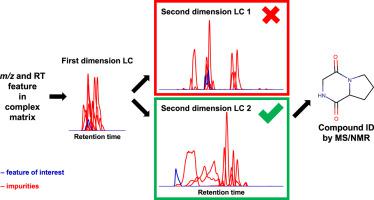当前位置:
X-MOL 学术
›
Anal. Chim. Acta
›
论文详情
Our official English website, www.x-mol.net, welcomes your
feedback! (Note: you will need to create a separate account there.)
Fractionation platform for target identification using off-line directed two-dimensional chromatography, mass spectrometry and nuclear magnetic resonance
Analytica Chimica Acta ( IF 5.7 ) Pub Date : 2021-01-01 , DOI: 10.1016/j.aca.2020.10.054 Tom van der Laan , Hyung Elfrink , Fatemeh Azadi-Chegeni , Anne-Charlotte Dubbelman , Amy C. Harms , Doris M. Jacobs , Ulrich Braumann , Aldrik H. Velders , John van Duynhoven , Thomas Hankemeier
Analytica Chimica Acta ( IF 5.7 ) Pub Date : 2021-01-01 , DOI: 10.1016/j.aca.2020.10.054 Tom van der Laan , Hyung Elfrink , Fatemeh Azadi-Chegeni , Anne-Charlotte Dubbelman , Amy C. Harms , Doris M. Jacobs , Ulrich Braumann , Aldrik H. Velders , John van Duynhoven , Thomas Hankemeier

|
The unambiguous identification of unknown compounds is of utmost importance in the field of metabolomics. However, current identification workflows often suffer from error-sensitive methodologies, which may lead to incorrect structure annotations of small molecules. Therefore, we have developed a comprehensive identification workflow including two highly complementary techniques, i.e. liquid chromatography (LC) combined with mass spectrometry (MS) and nuclear magnetic resonance spectroscopy (NMR), and used it to identify five taste-related retention time and m/z features in soy sauce. An off-line directed two-dimensional separation was performed in order to purify the features prior to the identification. Fractions collected during the first dimension separation (reversed phase low pH) were evaluated for the presence of remaining impurities next to the features of interest. Based on the separation between the feature and impurities, the most orthogonal second dimension chromatography (hydrophilic interaction chromatography or reversed phase high pH) was selected for further purification. Unknown compounds down to tens of micromolar concentrations were tentatively annotated by MS and structurally confirmed by MS and NMR. The mass (0.4-4.2 μg) and purity of the isolated compounds were sufficient for the acquisition of one and two-dimensional NMR spectra. The use of a directed two-dimensional chromatography allowed for a fractionation that was tailored to each feature and remaining impurities. This makes the fractionation more widely applicable to different sample matrices than one-dimensional or fixed two-dimensional chromatography. Five proline-based 2,5-diketopiperazines were successfully identified in soy sauce. These cyclic dipeptides might contribute to taste by giving a bitter flavour or indirectly enhancing umami flavour.
中文翻译:

使用离线定向二维色谱、质谱和核磁共振进行目标识别的分级平台
未知化合物的明确鉴定在代谢组学领域至关重要。然而,当前的识别工作流程经常受到错误敏感的方法的影响,这可能导致小分子的结构注释不正确。因此,我们开发了一个全面的鉴定工作流程,包括两种高度互补的技术,即液相色谱 (LC) 结合质谱 (MS) 和核磁共振光谱 (NMR),并用它来鉴定五种与味道相关的保留时间和 m酱油中的 /z 特征。进行离线定向二维分离以在识别之前纯化特征。评估在第一维分离(反相低 pH 值)期间收集的馏分是否存在与感兴趣的特征相邻的残留杂质。基于特征与杂质的分离,选择正交性最强的二维色谱(亲水相互作用色谱或反相高pH)进行进一步纯化。低至数十微摩尔浓度的未知化合物通过 MS 进行初步注释,并通过 MS 和 NMR 进行结构确认。分离化合物的质量 (0.4-4.2 μg) 和纯度足以获得一维和二维 NMR 谱。使用定向二维色谱允许根据每个特征和剩余杂质进行分馏。这使得分馏比一维或固定二维色谱更广泛地适用于不同的样品基质。在酱油中成功鉴定出五种基于脯氨酸的 2,5-二酮哌嗪。这些环状二肽可能通过提供苦味或间接增强鲜味来增加味道。
更新日期:2021-01-01
中文翻译:

使用离线定向二维色谱、质谱和核磁共振进行目标识别的分级平台
未知化合物的明确鉴定在代谢组学领域至关重要。然而,当前的识别工作流程经常受到错误敏感的方法的影响,这可能导致小分子的结构注释不正确。因此,我们开发了一个全面的鉴定工作流程,包括两种高度互补的技术,即液相色谱 (LC) 结合质谱 (MS) 和核磁共振光谱 (NMR),并用它来鉴定五种与味道相关的保留时间和 m酱油中的 /z 特征。进行离线定向二维分离以在识别之前纯化特征。评估在第一维分离(反相低 pH 值)期间收集的馏分是否存在与感兴趣的特征相邻的残留杂质。基于特征与杂质的分离,选择正交性最强的二维色谱(亲水相互作用色谱或反相高pH)进行进一步纯化。低至数十微摩尔浓度的未知化合物通过 MS 进行初步注释,并通过 MS 和 NMR 进行结构确认。分离化合物的质量 (0.4-4.2 μg) 和纯度足以获得一维和二维 NMR 谱。使用定向二维色谱允许根据每个特征和剩余杂质进行分馏。这使得分馏比一维或固定二维色谱更广泛地适用于不同的样品基质。在酱油中成功鉴定出五种基于脯氨酸的 2,5-二酮哌嗪。这些环状二肽可能通过提供苦味或间接增强鲜味来增加味道。











































 京公网安备 11010802027423号
京公网安备 11010802027423号